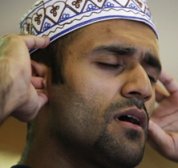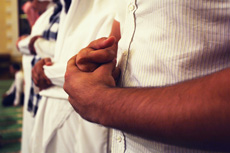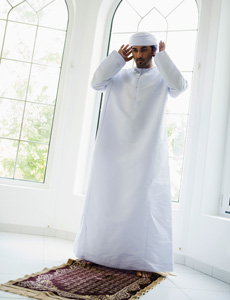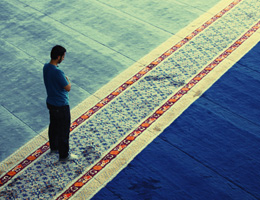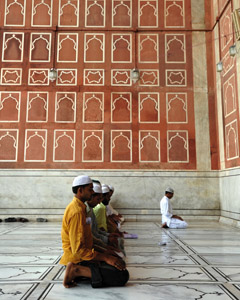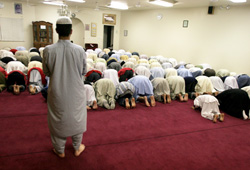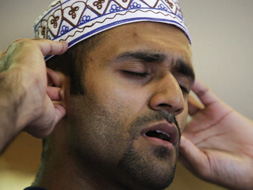The Pillars and the Obligatory Acts of the Prayer
The pillars (arkaan; singular: rukn) of the prayer are its essential parts that are necessary for its validity. If any of these pillars is left out due to forgetfulness or deliberate omission, the prayer becomes invalid.
They are as follows:
The opening takbeer; assuming the standing position, if one has the ability to do so; reciting Soorat Al-Faatihah (in the case of performing the prayer alone, i.e., not being led by an imaam); bowing; rising from the bowing position; prostrating, sitting between the two prostrations, the final tashahhud, sitting while reciting the tashahhud; the tasleem.; and making certain that each body part assumes the appropriate position before one moves from one position to another.
The obligatory acts of the prayer (waajibaat; singular: waajib)are those acts that must be done in the prayer. If they are deliberately omitted, the prayer becomes invalid. However, if they are left out due to inattention or forgetfulness, the prayer is still valid, but the acts that are left out can be compensated for with the two prostrations of forgetfulness, as will be explained later.
The obligatory acts of the prayer are as follows:
Recitation of takbeer throughout the prayer other than the opening takbeer; saying Subhaana rabbiy-al-‛adheem (Glory be to my Lord, the Almighty) once; saying Sami‛allaahu li man hamidah (Allah listens to him who praises Him), whether one is praying alone or one is the prayer leader (imaam); saying Rabbanaa wa lakal-hamd (Our Lord, to You is due all praise); Subhaana rabbiyal-a‛laa (Glory be to my Lord, Most High) once; saying Rabbighfir lee, (O Lord, forgive me) while sitting between the two prostrations once; and reciting the first tashahhud. These obligatory acts can be made up for with the two prostrations of forgetfulness.
The recommended acts of the prayer (sunan as-salaat) are those words and acts other than the pillars nor the obligatory acts of the prayer. They serve to complement the prayer and it is recommended to observe them. Omission of any of these acts, however, does not render the prayer invalid.
The Two Prostrations of Forgetfulness
These prostrations are generally performed to make up for any deficiency in the prayer.
When can they be performed?
They can be performed in the following cases:
- If a person forgetfully adds an extra act in the prayer, whether it is assuming an extra standing position, prostrate position, bowing position or sitting position, then he has to perform the two prostrations of forgetfulness at the end of the prayer.
- If he unintentionally leaves out any of the pillars of the prayer (arkaan), he must add the missing pillar and then perform the two prostrations of forgetfulness at the end of the prayer.
- If he unintentionally leaves out any of the obligatory acts of prayer (waajibaat), such as the first tashahhud, he must perform the prostrations of forgetfulness.
- If he is in doubt as to the number of the prayer units he has performed, he simply assumes he has performed the lesser number to be on the safe side and performs the two prostrations of forgetfulness at the end of the prayer.
Manner of Performing the Two Prostrations due to Forgetfulness: These can be performed in exactly the same manner he normally performs in the prayer; that is, by performing two prostrations and sitting between them.
When to Perform the Two Prostrations of Forgetfulness: They can be performed:
- After the final tashahhud and before reciting the tasleem, he performs the two prostrations of forgetfulness and then recites the tasleem as he normally does to conclude the prayer.
- After reciting the tasleem, he performs the two prostrations of forgetfulness and then recites the tasleem again.
Acts which Invalidate the Prayer
The prayer becomes invalid in the following cases:
- If any of its pillars (arkaan) or obligatory acts (waajibaat) are intentionally or forgetfully omitted despite one’s ability.
- If any of its obligatory acts (waajibaat) are intentionally left out.
- Deliberately speaking whilst in prayer.
- Laughing out loud whilst in prayer.
- Unnecessary, continuous movements.
Acts which Are Disliked During the Prayer
These are the acts which are bound to decrease the reward for one’s prayer and negatively affect humility, concentration and attentiveness in it. They are as follows:
- Turning the head around during prayer, for when the prophet ﷺ was asked about this act, he said, “It is a way of stealing by which Satan takes away a portion from a person’s prayer.” (Saheeh Al-Bukhaaree: 718)
- Fiddling with one’s hands or face, placing one’s hands on the hips, clasping one’s hands together and cracking one’s fingers.
- Engaging in prayer when one is distracted by something, such as one’s need to answer the call of nature, for the prophet ﷺ said, “No prayer can be correctly offered when the food is served before the worshipper, or when one is prompted by the call of nature.” (Saheeh Muslim: 560)
The Recommended Voluntary Prayers
Muslims are required to offer only five prayers a day.
However, Islam encourages them to offer other recommended prayers, for doing so makes them worthy of Allah’s love and serve to make up for any deficiencies in the performance of the obligatory prayers.
The following are some of the most important supererogatory prayers:
- The Supererogatory Prayers Accompanying the Obligatory Prayers (As-Sunan Ar-Rawaatib): These are the prayers that are offered before or after the obligatory prayers and Muslims generally do not neglect them. Regarding the reward for performing these prayers, the prophet ﷺ said, “Allah will build a house in Paradise for any Muslim who prays twelve units of voluntary prayer during the night and day.” (Saheeh Muslim: 728) They are as follows
| 1 | Two units before the Fajr prayer |
| 2 | Four units before the Dhuhr prayer, reciting the tasleem after each two units; and two other units after the Dhuhr prayer |
| 3 | Two units after the Maghrib prayer |
| 4 | Two units after the ‛Ishaa’ prayer |
- The Witr Prayer: the Arabic word witr means “odd number” and refers to odd-numbered prayer offered after the ‛Ishaa’ prayer. It is considered to be one of the best and most meritorious of all supererogatory prayers. The prophet ﷺ once commanded the Muslims, “Followers of the Qur’an! Perform the witr prayer.” (Sunan At-Tirmidhee: 453, Sunan Ibn Maajah: 1170)
The best time to offer the witr prayer is in the later part of the night before the Fajr prayer, but a Muslim may perform it at any time between the Ishaa’ and the Fajr prayers. The minimum number of units for the witr prayer is one, but it is better to offer three. A Muslim may offer more if he wishes, but the maximum number of units which the Prophet r used to perform was eleven. The units of the supererogatory prayers are generally offered two by two, followed by the tasleem. The witr prayer is no exception. However, if a Muslim wants to conclude his prayer, he must add one single unit, during which he may recite a special supplication, known as qunoot supplication. This supplication is recited after rising from the bowing position and before prostrating. After this supplication, he may pray to Allah and ask Him for whatever he wishes, holding his hands in front of him with both palms up.
Times During Which It Is Not Permissible to Offer the Supererogatory Prayers
A Muslim may offer a supererogatory prayer at any time, except at such times during which it is prohibited to offer them, as they are generally times specified for prayers offered by some non-Muslims. During these times, he is only allowed to make up for the obligatory prayers he may have missed or the supererogatory prayers which are offered for a reason, such as the prayer of tahiyyatul-masjid, ‘‘greeting the mosque”, a prayer which consists of two units and is performed upon entering the mosque and there is enough time to perform it before the obligatory prayer commences. A Muslim may, however, invoke Allah and recite supplications at any time.
These times are as follows:
| 1 | From the time following the Fajr prayer until the sunrises above the horizon by the length of a spear, a short period of time specified in Islamic Law and is equal to approximately twenty minutes in countries with a temperate climate. |
| 2 | From the time the sun is at its zenith until it declines westward from the middle of the sky. This is a short period of time preceding the beginning of the time of the Dhuhr prayer. |
| 3 | From the time following the ‛Asr prayer until sunset |
The Congregational Prayer
Allah ﷻ commands Muslim men to perform the five obligatory prayers in congregation and promises them a great reward for doing so. Mentioning the reward of the congregational prayer, the prophet ﷺ once said, “The reward for a prayer offered in congregation is twenty-seven times greater than that offered by a person alone.” (Saheeh Al-Bukhaaree: 619; Saheeh Muslim: 650)
The congregational prayer can be established by at least two people, one of them acts as the prayer leader (imaam). However, the larger the congregation, the dearer it is to Allah.
Following the Imam in Prayer
This means that those praying behind the imaam must do the same as he does during the prayer by observing all the prayer movements and taking all the prayer postures, such as bowing and prostrating, immediately after him. They must not engage in any movement or posture before him or differ with him in this respect in anything whatsoever.
The prophet ﷺ said, “The imaam is to be followed. Say Allaahu akbar when he says it, and do not say it until he says it first. Bow when he bows, and do not bow until he has done so first. When he says, sami‛-Allaahu liman hamidah (Allah listens to him who praises Him),’ say, “Rabbanaa wa lak-al-hamd (Our Lord, to You is due all praise).’ Prostrate when he prostrates, and do not prostrate until he has done so first” (Saheeh Al-Bukhaaree: 710, Saheeh Muslim: 414 and Sunan Abu Daawood: 603)
Who Should Lead the Prayer?
Generally speaking, the person who knows the Qur’an the best should be given preference in leading the prayer. If those present are equal in that respect, then the one who is best informed in the rules of religion , as the prophet ﷺ said, “ Let him act as imaam to a congregation who knows the Qur’an by heart the best; and if all present should be equal in that respect, then let him perform who has the deepest knowledge of the Sunnah…”(Saheeh Muslim: 673)
Where Does the Imaam and Those He Leads Standin Prayer?
The imaam stands in front of those he leads in prayer (ma’moomoon; singular: ma’moom /follower). The followers, standing shoulder to shoulder, form straight lines behind him, and the front rows should be filled and completed first. If there is only one follower (ma’moom), he positions himself to the right of the imaam.
How to Make up for Missed Prayer Units
If the prayer has already started, the latecomer should join in the congregation in the very position in which he finds the imaam. For example, if he finds the imaam in the prostrate position, he must recite the takbeer and then prostrate himself. When the imaam concludes the congregational prayer by reciting the tasleem, the latecomer rises, reciting the takbeer, to assume a standing position and complete the rest of the prayer individually, by making up for the units he has missed.
The unit (rak‛ah) that he catches up with the imaam when he first joins the congregation counts as the beginning of his own prayer, and whatever he makes up for after the imaam concludes the congregational prayer counts as the rest of his prayer.
How to Determine that a Complete Rak‛ah Is Offered
The prayer is determined by the number of units offered in it; if a latecomer joins the congregation while the imaam is in the bowing position, he is considered to have offered a complete unit (rak‛ah) even though he has not recited Soorat Al- Faatihah in that particular rak‛ah in the standing position. If, however, he misses the bowing position, then he mus trecite the takbeer and join the congregation. In this case, he is considered to have missed this particular rak‛ah and whatever movements and postures in it do not count.
Examples Illustrating Ways of Making up for Missed Prayer Units
If someone joins the congregation during the Fajr prayer while the imaam is in the second rak‛ah, he must, after the imaam concludes the prayer with the tasleem, rise, reciting the takbeer, to assume a standing position and make up for the other rak‛ah which he has missed. He must not recite the tasleem until he completes the prayer, for the Fajr prayer consists of two units and he has only offered one unit with the imaam.
If he joins the congregation during the Maghrib prayer while the imaam is in the sitting position reciting the final tashahhud, he must, after the imaam concludes the prayer with the tasleem, rise, reciting the takbeer, to assume a standing position and offer three complete units of prayer. The reason for this is that he has joined the congregation only at its end while the imaam is reciting the final tashahhud. A unit (rak‛ah) only counts as complete if one joins the congregation while the imaam is in the bowing posture.
If he joins the congregation during the Dhuhr prayer while the imaam is in the bowing position of the third rak‛ah, then this means that he has offered two complete units of prayer, which count for him as his two first units. As soon as the imaam concludes the prayer with the tasleem, he must then rise, reciting the takbeer, to assume a standing position and offer two more units, namely the third and fourth units, considering that the Dhuhr prayer consists of four units of prayer.
The Call to Prayer (Adhaan)
The adhaan serves the purpose of calling people to prayer and signalling the beginning of the time of an obligatory prayer. Another call, called the iqaamah, serves the purpose of summoning Muslims to line up for the beginning of the obligatory prayers. Muslims used to meet up and seek to know the time of prayer, but no one summoned them. One day they were discussing how to gather everyone for prayer.
Some suggested using a bell as the Christians do, and others recommended using a ram’s horn, following an ancient Jewish practice. Then ‛Umar ibn Al-Khattaab t, one of the Prophet’s companions, suggested appointin gsomeone to call people to prayer. The Prophet agreed, so he turned to Bilal t, and said, “Get up, Bilaal, and call the people to prayer.” (Saheeh Al-Bukhaaree: 579; Saheeh Muslim: 377)
The Manner of Reciting the Adhaan and the Iqaamah
- Both the adhaan and the iqaamah must be recited in the case of a group of people (congregation) but it is not the case with an individual. If a congregation intentionally leave it out, their prayer will still be valid but they will be considered sinners.
- The adhaan ought to be recited in a nice and loud voice so people can hear it and come to the mosque and perform the congregational prayer.
- The adhaan has different formulas, all approved by the prophet ﷺ. The following is the common formula:
The Iqaamah
- Allaahu akbar, Allaahu akbar “Allah is the greatest of all, Allah is the greatest of all”
- Ash hadu an laa ilaaha illallaah “ I bear witness that there is no God worthy of worship except Allah”
- Ash hadu anna Muhammadan rasoolullaah “ I bear witness that Muhammad is the Messenger of Allah”
- Hayya ‛alassalaah “Come to prayer”
- Hayya ‛alal-falaah“Come to success”
- Qad qaamat-issalaatu, qad qaamat-issalaah “ The prayer is about to begin, the prayer is about to begin”
- Allaahu akbar, Allaahu akbar “Allah is the greatest of all, Allah is the greatest of all”
- laa ilaaha illallaah “There is no God worthy of worship except Allah”
The Adhaan
- Allaahu akbar “Allah is the greatest of all” (four times)
- Ash hadu an laa ilaaha illallaah “ I bear witness that there is no god worthy of worship except Allah” (twice)
- Ash hadu anna Muhammadan rasoolullaah “I bear witness that Muhammad is the Messenger of Allah” (twice)
- Hayya ‛alassalaah “Come to prayer” (twice)
- Hayya ‛alal-falaah “Come to success” (twice)
- Allaahu akbar “Allah is the greatest of all” (twice)
- laa ilaaha illallaah “ There is no god worthy of worship except Allah” (once)
Responding to the Adhaan
It is recommended, upon hearing each statement of the adhaan, to repeat after the mu’ath-thin (the caller to prayer) and say exactly as he says, except when he says Hayya ‛alassalaah “Come to prayer” or Hayya ‛alal-falaah “Come to success”, in which case one must say: Laa hawla wa laa quwwata illaa billaah, which means “There is neither might nor power except with Allah”.
It is recommended to recite the following supplication after the adhaan: Allaahumma rabba haadhih-id-da‛wat-it-taammati, wassalaat-il-qaa’imati, aati Muhammadan-il-waseelata wal-fadeelata, wab‛athu maqaaman mahmoodan alladhee wa‛adtah (O Allah! Lord of this perfect call and this established prayer, grant Muhammad the intercession and favour,and raise himto the Praiseworthy Station which You have promised him)
